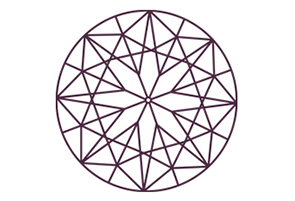Symmetry
T his sections contains all you need to know about diamond symmetry when buying diamond engagement rings and diamond jewellery
Create Your Own
Shop By Style
Shop By Metal
Eternity Rings
Shop By Metal
Shop By Category
Help & Guidance
The Stone Way
CHESHIRE
150 Ashley Road, Hale,
Cheshire, WA15 9SA
0161 233 9977
MANCHESTER
Third Floor, St Johns Court, 19B Quay Street,
Manchester, M3 3HN
0800 080 3535
LONDON
5 St Christopher’s Pl, Marylebone,
London, W1U 1NA
020 33 271 271
T his sections contains all you need to know about diamond symmetry when buying diamond engagement rings and diamond jewellery
Diamonds are graded based on their 4Cs, however other characteristics such as fluorescence, symmetry and polish have a significant impact on the diamond’s value and overall appearance and influence the stone’s cut grade. Poor diamond symmetry will affect the stone’s light dispersion, making your engagement ring or diamond jewellery less brilliant.
The symmetry of a diamond refers to the arrangement, outline evenness, symmetry of facets and accuracy of the diamond shape. According to GIA standards, 10 different characteristics are considered during the symmetry grade evaluation. Symmetry is graded Excellent, Very Good, Good, Fair and Poor. An Excellent cut diamond would have Excellent or Very Good symmetry grade. GIA experiments show that symmetry grade below Very good influences the appearance of diamonds with cut grade Good and below, but now with Very Good and above.

We would only recommend purchasing a diamonds with symmetry grade of Very Good and above, as their symmetrical flaws can not be seen with the unarmed eye. Diamonds with symmetry grades below Good may possess visible flaws and would never receive the highest cut grades.
Steven Stone experts recommend purchasing diamond jewellery and diamond engagement rings with Excellent cut grade, which possess Very Good or Excellent symmetry grade. A Good grade does not necessarily mean that the diamond’s light performance and overall looks would be affected, however that would entirely depend on the cut. Choosing a diamond with a symmetry grade below Good would most likely affect the diamond’s cut, which is the stone’s appearance most substantial feature.
"Symmetry is crucial to the fire and scintillation of the diamond. We recommend purchasing diamonds with either Very Good or Excellent grade, as the symmetry can affect the overall aesthetics of the stones"
According to GIA standards, 10 different characteristics are considered during the symmetry grade evaluation. Listed below are the symmetry flaws which can lower a diamond’s symmetry grade and decrease the cut grade
An out-of-round diamond shape differs from the perfectly round diamond in width to length ratio. A round diamond with Excellent or Very Good symmetry grade would have equal width and length diameters. For Excellent symmetry grade diamonds, GIA allows between 0 and 0.9% deviation in width and length diameter. If the stone’s measurements have a deviation greater than 0.9% in width to length diameter, the diamond’s symmetry grade is lowered to Very Good. Diamonds with deviations between 1.9 and 3.6% have Good symmetry grade.
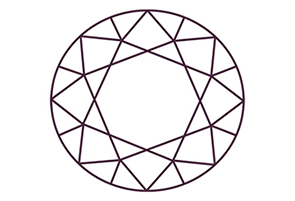
The table facet is considered off-centre if one of its edges is further away from the centre than another of its edges, and it appears as the table facet is not centralised when viewed from above. To establish the distance between the centre and table facet edges, gemmologists measure the distance between the two and compare it to the average diameter of the stone. A deviation below 0.6% is required for a diamond to be classed with Excellent symmetry grade.

The culet is the tip at the bottom of the diamond’s pavilion. If off-centre, it looks like the point where the pavilion mains meet is not centralized when the stone is looked at from face-up view. When projected on a horizontal plane, the deviation in distance between the culet centre and outline centre should be 0.6% or less, for the diamond to receive a Very Good symmetry grade.
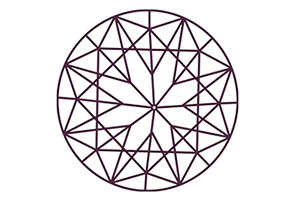
The Table and Culet alignment symmetry flaw refers to a misplacement of the table facet and culet. It appears as they were placed in opposite directions. For the table and culet alignment to be measured, the distance between the table centre and the culet centre is projected into the table plane, as a percentage of the average diameter. Diamonds would be awarded a symmetry grade of Very Good ff the distance is greater than 0.9%.

A perfectly cut diamond would have the exact same crown height measurements in all of its 8 measured angles. However, due to unparalleled table and girdle or a wavy girdle, the crown’s height can vary. For a stone to be graded with Excellent symmetry grade, the highest and lowest crown height values should not differ more than 1.2% of the average diameter of the diamond.
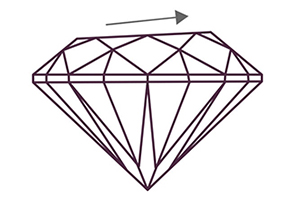
Usually due to an off-centre table, the crown angles are created unequal. The angle variation is measured in degrees, by comparing the maximum and minimum crown angle values. The difference in values must be lower than 1.2 degrees, for a diamond to receive an Excellent symmetry grade.

The pavilion depth variation symmetry flaw refers to the difference between the highest and lowest pavilion depth values and usually occurs due to a wavy girdle. For a diamond to be graded with Excellent symmetry grade, the difference between highest and lowest pavilion depth values should be smaller than 1.2% of the average diameter.
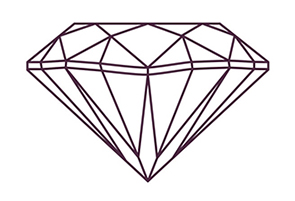
If the diamond’s culet is off-centre, its angles will be unequal. Diamond angle variation is measured in degrees, by comparing the maximum and minim pavilion angle values. If the difference is higher than 0.9%, the symmetry grade will be decreased.
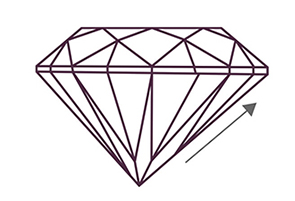
A girdle thickness variation refers to a variation of the girdle thickness at bezel positions. The bezel facets form the crown and are located where the crown meets the girdle. It is the difference between the minimum and maximum girdle thickness values, measured in percentage of the average diameter, at main bezel junctions, around the diamond’s rim. If the variation is higher than 1.2% of the average diameter, the symmetry grade will be decreased.
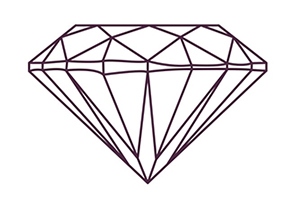
Table size variation refers to the difference between the highest and lowest diamond table size values. It is measured in percentage of the average diameter. For a diamond to be graded with Excellent symmetry, the table size variation should not be greater than 1.2%.
